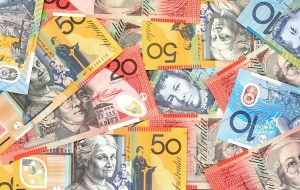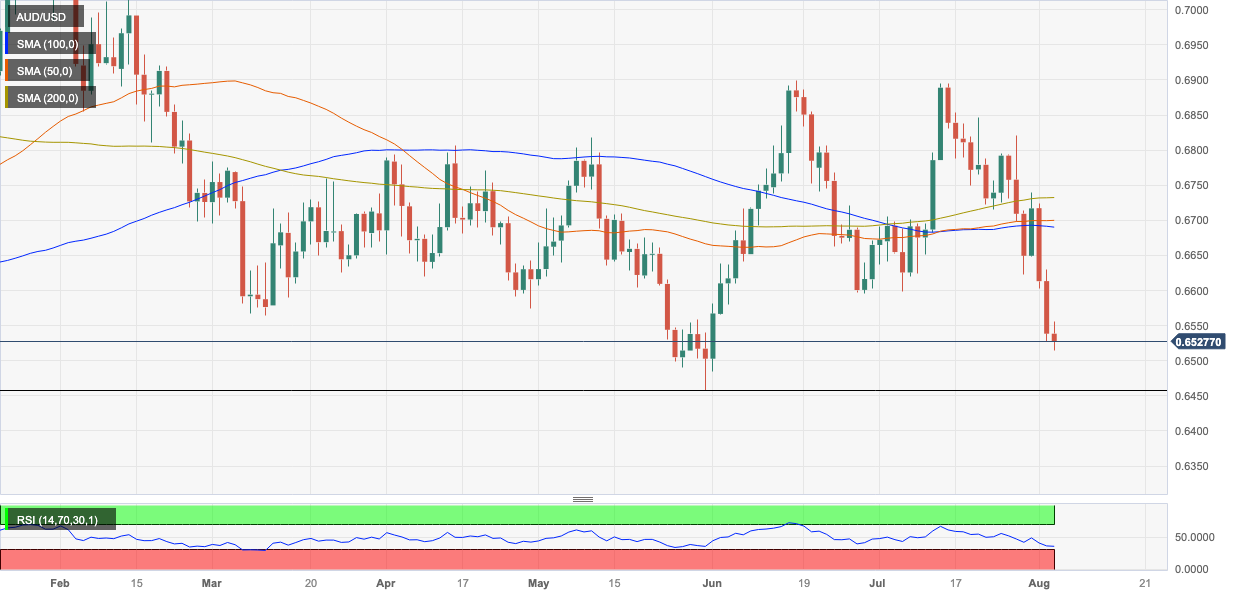Australian Dollar finds a floor after upbeat Australian trade and Chinese services’ data
Share: Australian Dollar falls to a temporary support level against the US Dollar on Thursday. The Aussie is relieved by upbeat Australian trade balance data and Chinese services sector PMIs. The general market mood remains depressed, however, broadly favoring the USD over the AUD. The Australian Dollar (AUD) finds temporary support against the US

- Australian Dollar falls to a temporary support level against the US Dollar on Thursday.
- The Aussie is relieved by upbeat Australian trade balance data and Chinese services sector PMIs.
- The general market mood remains depressed, however, broadly favoring the USD over the AUD.
The Australian Dollar (AUD) finds temporary support against the US Dollar (USD) on Thursday, after its recent relentless battering. Figures showing Australia achieved a higher-than-expected trade surplus of $11,321 million in June helped steady the ship, as did favorable Caixin Chinese Services PMIs which registered an unexpected 54.1 in July.
Australia’s largest export Iron Ore, however, further declines, weighing on the Australian Dollar, with Chinese Iron Ore (62%) Futures reaching a new low for July in the $107s.
AUD/USD trades in the 0.65s during the US session.
Australian Dollar news and market movers
- The Australian Dollar loses ground initially on Thursday but finds a floor after the release of the Australian Trade Balance in June, which beats expectations of 11,000M with an $11,321M print. This is also higher than the $10,497M in May.
- China Caixen Services PMI in July also beats expectations of 52.5 by coming out at 54.1 from 53.9 in the previous month of June. As Australia’s largest trading partner this is good news for the Aussie.
- The US Dollar continues to rally despite US debt being downgraded to AA+ from AAA by credit rating agency Fitch on Monday. The rise in the Dollar despite the downgrade is paradoxically due to the overall negative market mood which tends to benefit safe-havens like the US Dollar, argues FXStreet Lead Analyst Eren Sengezer.
- The US Dollar was also supported on Wednesday by data from US private sector payroll processor ADP which registered the addition of 324K new workers in July when only a 189K increase had been forecast by economists, although the figure was still below the 497K in June.
- US Initial Jobless Claims come out at 227K exactly in line with expectations according to the US Department of Labor on Thursday, further slowing the USD’s rise and the Aussie’s rout.
- The Australian Dollar was already on a weak footing after the RBA left the policy rate unchanged at 4.1% on Tuesday morning, against the market expectation for a 25 basis points hike. In the policy statement, the RBA explained that the decision to hold rates unchanged would provide them more time to assess the impact of policy tightening to date and the economic outlook.
- That said, they did not completely rule out the possibility of more rate hikes in the future, “Some further tightening of monetary policy may be required to ensure that inflation returns to target in a reasonable timeframe, but that will depend upon the data and the evolving assessment of risks,” the RBA noted.
- The next key release for the pair is weekly Initial Jobless Claims in the US, later in the day, the US ISM services PMI survey for July, and Unit Labor Costs data for the second quarter.
Australian Dollar technical analysis
Despite AUD/USD’s short-term bearish inclination, looked at on a longer-term weekly chart it is broadly in a sideways trend. The February high at 0.7158 is a key ceiling level, which if vaulted, will alter the outlook to one that is more bullish longer term.
Likewise, the downside, the 0.6458 low established in June is a key level for bears, which if breached decisively, would give the chart a more bearish overtone. Price is currently moving down nearer to this key low.
Australian Dollar vs US Dollar: Weekly Chart
Price has now broken cleanly through the confluence of moving averages (MA) close to 0.6700, made up of most of the major SMAs – the 50-week, 50-day and 100-day. The breaching of this key support and resistance level is a bearish sign.

Australian Dollar vs US Dollar: Daily Chart
It is possible price may have completed a Measured Move pattern or three wave ABC correction (see daily chart), in July. If so, there is a chance it may be about to start a short-term upcycle. Given how bearish price action is at the moment, however, the chances of this scenario unfolding are diminishing by the hour.
AUD/USD has now also broken below the 0.6600 June lows on an intraday basis, and a continuation down to the key May lows at 0.6460, is quite possible. A decisive break below them would open the way for a move down to 0.6170 and the 2022 lows.
Because the pair is in a sideways trend overall it is unpredicatable and the probabilities do not favor either bears or bulls overall – nor is the Relative Strength Index (RSI) providing much insight on either timeframe.
In technical terms, a ‘decisive break’ consists of a long daily candlestick, which pierces cleanly above or below the critical level in question and then closes near to the high or low of the day. It can also mean three up or down days in a row that break cleanly above or below the level, with the final day closing near its high or low and a decent distance away from the level.
RBA FAQs
The Reserve Bank of Australia (RBA) sets interest rates and manages monetary policy for Australia. Decisions are made by a board of governors at 11 meetings a year and ad hoc emergency meetings as required. The RBA’s primary mandate is to maintain price stability, which means an inflation rate of 2-3%, but also “..to contribute to the stability of the currency, full employment, and the economic prosperity and welfare of the Australian people.” Its main tool for achieving this is by raising or lowering interest rates. Relatively high interest rates will strengthen the Australian Dollar (AUD) and vice versa. Other RBA tools include quantitative easing and tightening.
While inflation had always traditionally been thought of as a negative factor for currencies since it lowers the value of money in general, the opposite has actually been the case in modern times with the relaxation of cross-border capital controls. Moderately higher inflation now tends to lead central banks to put up their interest rates, which in turn has the effect of attracting more capital inflows from global investors seeking a lucrative place to keep their money. This increases demand for the local currency, which in the case of Australia is the Aussie Dollar.
Macroeconomic data gauges the health of an economy and can have an impact on the value of its currency. Investors prefer to invest their capital in economies that are safe and growing rather than precarious and shrinking. Greater capital inflows increase the aggregate demand and value of the domestic currency. Classic indicators, such as GDP, Manufacturing and Services PMIs, employment, and consumer sentiment surveys can influence AUD. A strong economy may encourage the Reserve Bank of Australia to put up interest rates, also supporting AUD.
Quantitative Easing (QE) is a tool used in extreme situations when lowering interest rates is not enough to restore the flow of credit in the economy. QE is the process by which the Reserve Bank of Australia (RBA) prints Australian Dollars (AUD) for the purpose of buying assets – usually government or corporate bonds – from financial institutions, thereby providing them with much-needed liquidity. QE usually results in a weaker AUD.
Quantitative tightening (QT) is the reverse of QE. It is undertaken after QE when an economic recovery is underway and inflation starts rising. Whilst in QE the Reserve Bank of Australia (RBA) purchases government and corporate bonds from financial institutions to provide them with liquidity, in QT the RBA stops buying more assets, and stops reinvesting the principal maturing on the bonds it already holds. It would be positive (or bullish) for the Australian Dollar.
.
لینک منبع : هوشمند نیوز
 آموزش مجازی مدیریت عالی حرفه ای کسب و کار Post DBA آموزش مجازی مدیریت عالی حرفه ای کسب و کار Post DBA+ مدرک معتبر قابل ترجمه رسمی با مهر دادگستری و وزارت امور خارجه |  آموزش مجازی مدیریت عالی و حرفه ای کسب و کار DBA آموزش مجازی مدیریت عالی و حرفه ای کسب و کار DBA+ مدرک معتبر قابل ترجمه رسمی با مهر دادگستری و وزارت امور خارجه |  آموزش مجازی مدیریت کسب و کار MBA آموزش مجازی مدیریت کسب و کار MBA+ مدرک معتبر قابل ترجمه رسمی با مهر دادگستری و وزارت امور خارجه |
 مدیریت حرفه ای کافی شاپ |  حقوقدان خبره |  سرآشپز حرفه ای |
 آموزش مجازی تعمیرات موبایل آموزش مجازی تعمیرات موبایل |  آموزش مجازی ICDL مهارت های رایانه کار درجه یک و دو |  آموزش مجازی کارشناس معاملات املاک_ مشاور املاک آموزش مجازی کارشناس معاملات املاک_ مشاور املاک |
برچسب ها :AUDUSD ، Australia ، Australian ، Chinese ، Data ، Dollar ، Finds ، Floor ، Fundamental Analysis ، Services ، Technical analysis ، Trade ، Upbeat
- نظرات ارسال شده توسط شما، پس از تایید توسط مدیران سایت منتشر خواهد شد.
- نظراتی که حاوی تهمت یا افترا باشد منتشر نخواهد شد.
- نظراتی که به غیر از زبان فارسی یا غیر مرتبط با خبر باشد منتشر نخواهد شد.





ارسال نظر شما
مجموع نظرات : 0 در انتظار بررسی : 0 انتشار یافته : ۰